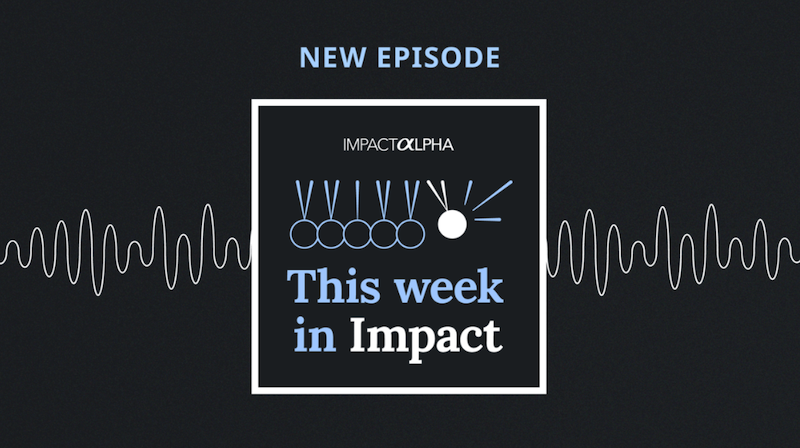ImpactAlpha, Feb. 29 – In October 2021, a paper manufacturer in Kalamazoo, Michigan, issued $100 million of what it called “green bonds” through a Michigan state conduit authority. The bonds were designated as green, the company wrote in the deal’s offering statement, because the proceeds would be used to build a recycling facility.
Nowhere in the offering statement was there any mention of a long history of pollution violations in the mostly-Black neighborhood where Graphic Packaging International intended to build its new facility, information that investors interested in environmental issues would surely have liked to know.
Coincidentally, the municipal bond market’s principal regulator, the Municipal Securities Rulemaking Board, a few weeks later announced it was soliciting input on how environmental, social, and governance principles should be represented in the market.
The municipal bond market comprises more than 50,000 issuers across demographics and geographies, Getting “Muniland” to agree to anything – let alone compliance red tape – is the definition of herding cats.
The Graphic Packaging deal highlights the problems inherent in a marketplace with no agreed-upon standards. The rulemaking board’s initiative, limited as it may have been, was seen as a necessary first step in what’s likely to be a long and winding road.
The head of the MSRB, Mark Kim, tells ImpactAlpha that he expects market participants to continue innovating. He pointed to Chicago’s recent social bond as one example.
“We are seeing our market evolve, and examples of robust disclosure that I think will provide a model for other issuers to emulate,” Kim says. “So I see progress. And that’s a good thing.”
Kim says efforts by the SEC to encourage climate disclosure requirements by public corporations might catalyze progress in the muni market, as a first step toward a “regulatory framework for the broader marketplace.”
Materiality
Observers say muni finance will need all the help it can get in bringing to market ESG standards.
“I can’t think of any precedent for this in the muni market,” says Justin Marlowe, a professor at the University of Chicago’s Harris School of Public Policy, referring to the questions facing the market as well as the lack of consensus.
He sees a bifurcated market: Some participants believe standards for ESG measurement and disclosure will eventually emerge. Others say “state and local governments are so dissimilar that you’ll never arrive at standards.”
“Nobody disputes climate change is real, and yet you can get very different estimates on how it’s going to unfold,” he says. “When you try to hold that up against the materiality standard that an auditor or a credit analyst has to adhere to, that falls apart quickly.”
The 52 comment letters received by the MSRB in response to its request for information make it clear how difficult it will be to reach consensus.
An industry group, the Government Finance Officers Association, noted that “there currently is no need for issuers to expressly expand disclosure in their official statements and other offering documents expressly devoted to ESG-related disclosures.” The association pointed to “concerns expressed by many market participants over the years that quality of information is far more important than the quantity.”
The City of Detroit wrote that it agreed with the association’s guidance “that standardized ESG disclosures would be overly burdensome, costly, and potentially inhibiting for municipal issuers who could decide not to use ESG designations they deserve to avoid the added cost and effort. Voluntary disclosures make the most sense for the municipal market.”
Kim says the Municipal Securities Rulemaking Board agrees. “There is also a fairly prevalent comment that regulation is premature,” he says.
Ironically, Kim was formerly the CFO of DC Water, the utility responsible for issuing, in 2014, the first “certified” green bond in the U.S. debt capital markets that came with an independent second-party sustainability opinion.
Low-cost capital
Without a strong push from a regulator with teeth — the MSRB has the ability to set rules but not enforce them — standards will likely have to come from another source.
The broad acceptance of ESG principles in markets around the world is likely to be the catalyst that urges the muni market forward, and proof that it need not be difficult, says Phillip Ludvigsen, a long-time ESG consultant specializing in financing and project certification.
He points to the worldwide takeup of principles promulgated by PRI, now totalling $120 trillion in assets under management, and including Chinese entities, as confirmation of the demand for ESG verifications.
“The number one systemic risk to the municipal securities market is ‘greenwash’ defined as the loss of market confidence due to the lack of evidence-based verification of specific conformance to self-declared requirements, accepted industry standards or compliance with official government regulations,” Ludvigsen wrote in a comment letter to the RFI.
Ludvigsen told ImpactAlpha most municipal governments will be guided by the bottom line. “When it comes to green muni bonds, I’ve seen a lot of movement mainly because of the lower cost of capital,” he says.
Market catalyst
For his part, Justin Marlowe believes that the federal government, in the form of tax credits and subsidies for renewable-energy projects in the 2022 Inflation Reduction Act, may mobilize some action. The IRA allows municipalities to issue taxable bonds to pay for qualifying projects, and then claim from the federal government a payment equal to the amount of income tax that bond investors would have avoided under a traditional tax-exempt scheme.
That “direct-pay” financing structure will hopefully draw non-traditional investors into the municipal market, which is now dominated by investors for whom the tax exemption is the single biggest draw. That may include younger investors, Europeans, corporate bond investors, or others for whom more attention to ESG is second nature.
“This is going to have a dramatic impact on how municipal finance is brought to bear on certain types of projects like renewables,” Marlowe says. “We need to watch to see if it draws new investors into the space and if you can get to a critical mass so that the traditional tax-exempt old-school muni perspective is balanced out.”












